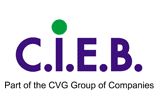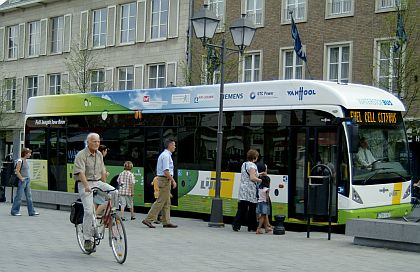
Jako ilustraní foto poskytl Van Hool obrázek vodíkového busu pro
belgického dopravce De Lijn
(CZ + EN) (Van Hool to supply 5 fuel cell buses for Oslo, Norway)
(CZ + EN) (Van Hool to supply 5 fuel cell buses for Oslo, Norway)
Po objednávce na 16 autobusů na vodíkové palivové články do USA (foto viz odkaz níže), vyhrál Van Hool zakázku na 5 takových autobusů pro Ruter A/S v norské metropoli Oslo. Zakázka je součástí evropského programu vodíkových autobusů.
Van Hool vybojoval soutěž s třináctimetrovým třínápravovým vozidlem vyvinutým v roce 2007 pro belgického dopravce De Lijn. Vozidla pro Oslo budou osazeny nejnovějšími zařízeními v oblasti palivových článků (kanadský Ballard Power Systems), litiovými bateriemi a elektromotorem Siemens. Autobus jezdí na elektřinu z vodíkových palivových článků a emisemi je vodní pára. Brzdicí energie je rekuperovaná. Autobusy budou mít nerezový rám a obložení stěn, troje dveře a 37 sedadel s pohledem cestujících dopředu. Budou dodané před koncem roku 2011.
Ve Flandrách se uskutečňuje také několik pokračujících demonstračních projektů koordinovaných WaterstofNet, zahrnující využití vodíku, s programem Interreg. Například přístav Antverpy Solvay buduje 1 MW elektrárnu využívající zbytkový vodík z průmyslu. Odpadní vodík je ideální pro využití jako palivo do autobusů (BUSportál: V ČR se to bohužel nepovedlo - odpadní vodík z Neratovic nepřečištěný nelze použít, a tak se používá pro neratovický vodíkový autobus vodík z Ostravy vyrobený ze zemního plynu). WaterstofNet aktuálně zakoupil plnicí stanici od Hydrogenics v Oevelu.
Z TZ Van Hool. Kompletní v angličtině.
Van Hool, which is increasingly acquiring a reputation for using the most advanced environmental technologies in public transport, received the order for 5 fuel cell buses after responding to an international call for tenders by Ruter A/S in Oslo.
Van Hool beat off the competition with a 13 m long tri-axle vehicle developed in 2007 to meet the requirements specified by Belgian public transport company De Lijn and based on the positive results revealed upon completion of the 24-month trial period and 100,000 km: zero emissions (complete absence of harmful gases and CO2), greatly reduced noise and high availability. In addition, the vehicles for Oslo will be equipped with the latest technological developments in the area of fuel cells (from the Canadian company Ballard Power Systems), lithium batteries and Siemens electric motors. Bearing in mind the specific use to which they will be put in Oslo, the buses will have a stainless steel frame and panelling, three doors and 37 forward-facing seats.
The bus is electrically powered. Hydrogen is converted into electricity in the fuel cell, with water vapour as the only emission, while the batteries provide backup where and when necessary. Braking energy is recovered in full, so that hydrogen consumption is minimal.
Also a number of on-going demonstration projects, under coordination from WaterstofNet, involving the use of hydrogen are currently taking place in Flanders within the Interreg program. For example, in the port of Antwerp Solvay is building a 1MW electricity plant using residual hydrogen from the industrial production process. A waste product, this residual hydrogen is ideal for use as a fuel to drive buses. And WaterstofNet has recently bought a hydrogen filling station from Hydrogenics in Oevel.
The Van Hool buses will be delivered before the end of 2011.
Van Hool is a Belgian independent bus, coach and industrial vehicle manufacturer. Van Hool has led the way for years with its development of environmentally friendly, low-floor buses, coaches to suit every taste and semitrailers and tank containers for optimum return.
PR Van Hool
Van Hool vybojoval soutěž s třináctimetrovým třínápravovým vozidlem vyvinutým v roce 2007 pro belgického dopravce De Lijn. Vozidla pro Oslo budou osazeny nejnovějšími zařízeními v oblasti palivových článků (kanadský Ballard Power Systems), litiovými bateriemi a elektromotorem Siemens. Autobus jezdí na elektřinu z vodíkových palivových článků a emisemi je vodní pára. Brzdicí energie je rekuperovaná. Autobusy budou mít nerezový rám a obložení stěn, troje dveře a 37 sedadel s pohledem cestujících dopředu. Budou dodané před koncem roku 2011.
Ve Flandrách se uskutečňuje také několik pokračujících demonstračních projektů koordinovaných WaterstofNet, zahrnující využití vodíku, s programem Interreg. Například přístav Antverpy Solvay buduje 1 MW elektrárnu využívající zbytkový vodík z průmyslu. Odpadní vodík je ideální pro využití jako palivo do autobusů (BUSportál: V ČR se to bohužel nepovedlo - odpadní vodík z Neratovic nepřečištěný nelze použít, a tak se používá pro neratovický vodíkový autobus vodík z Ostravy vyrobený ze zemního plynu). WaterstofNet aktuálně zakoupil plnicí stanici od Hydrogenics v Oevelu.
Z TZ Van Hool. Kompletní v angličtině.
BUSportál CZ na veletrhu BUSWORLD 2009: Vodíková flotila Van Hool míří do USA
Van Hool to supply 5 fuel cell buses for Oslo, Norway
Following the order for 16 fuel cell buses for the United States, Van Hool has now won an order for 5 fuel cell buses for Oslo in Norway. The order is part of the European programme for hydrogen buses.Van Hool, which is increasingly acquiring a reputation for using the most advanced environmental technologies in public transport, received the order for 5 fuel cell buses after responding to an international call for tenders by Ruter A/S in Oslo.
Van Hool beat off the competition with a 13 m long tri-axle vehicle developed in 2007 to meet the requirements specified by Belgian public transport company De Lijn and based on the positive results revealed upon completion of the 24-month trial period and 100,000 km: zero emissions (complete absence of harmful gases and CO2), greatly reduced noise and high availability. In addition, the vehicles for Oslo will be equipped with the latest technological developments in the area of fuel cells (from the Canadian company Ballard Power Systems), lithium batteries and Siemens electric motors. Bearing in mind the specific use to which they will be put in Oslo, the buses will have a stainless steel frame and panelling, three doors and 37 forward-facing seats.
The bus is electrically powered. Hydrogen is converted into electricity in the fuel cell, with water vapour as the only emission, while the batteries provide backup where and when necessary. Braking energy is recovered in full, so that hydrogen consumption is minimal.
Also a number of on-going demonstration projects, under coordination from WaterstofNet, involving the use of hydrogen are currently taking place in Flanders within the Interreg program. For example, in the port of Antwerp Solvay is building a 1MW electricity plant using residual hydrogen from the industrial production process. A waste product, this residual hydrogen is ideal for use as a fuel to drive buses. And WaterstofNet has recently bought a hydrogen filling station from Hydrogenics in Oevel.
The Van Hool buses will be delivered before the end of 2011.
Van Hool is a Belgian independent bus, coach and industrial vehicle manufacturer. Van Hool has led the way for years with its development of environmentally friendly, low-floor buses, coaches to suit every taste and semitrailers and tank containers for optimum return.
PR Van Hool
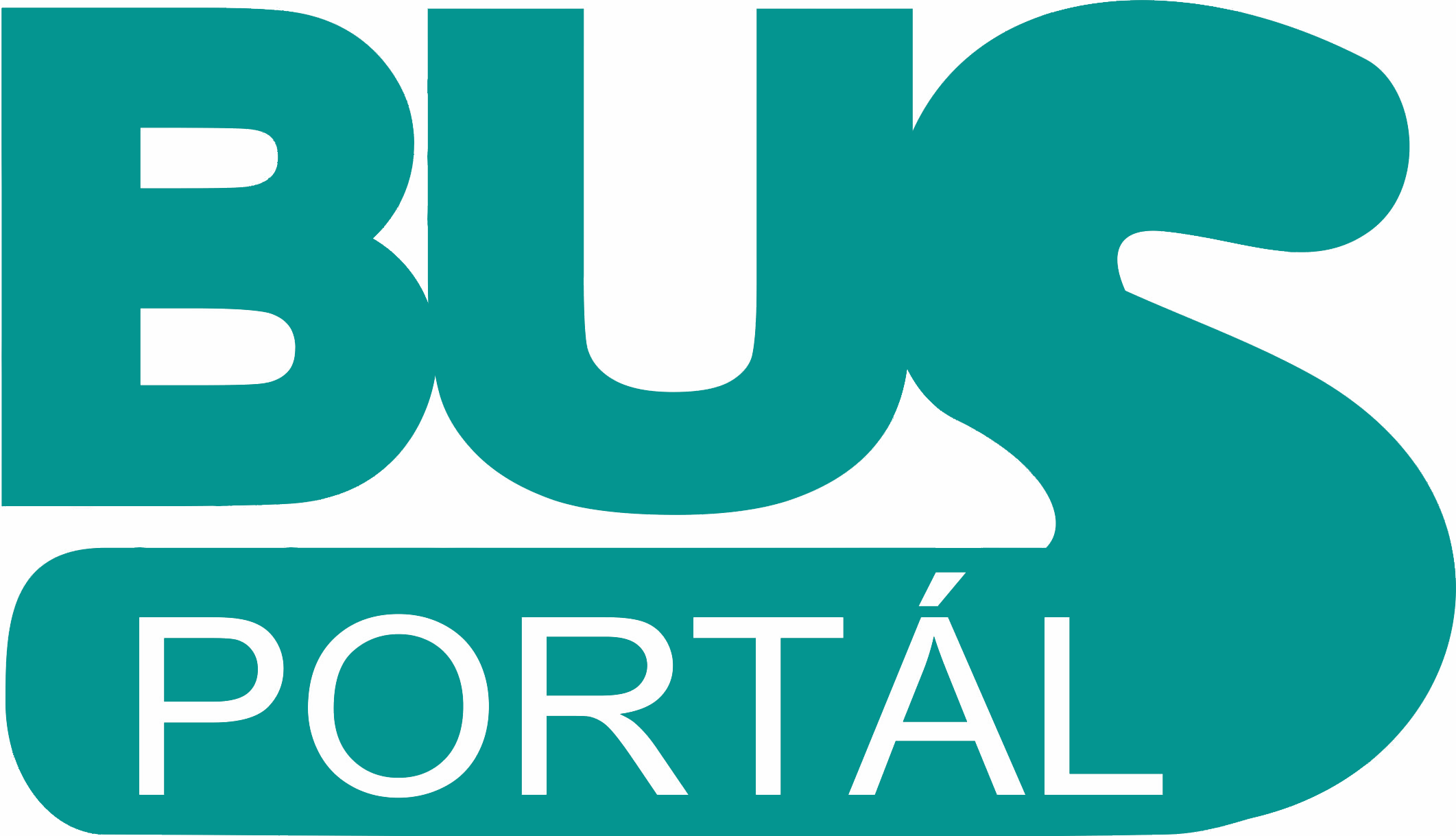


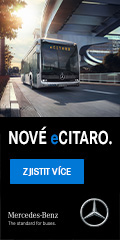

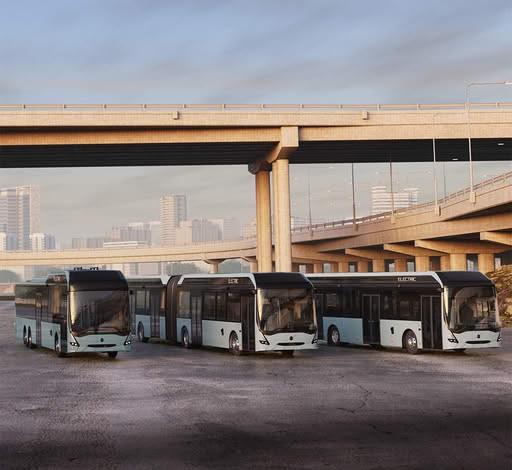 Volvo dodá 73 nových elektrických autobusů do švédského…
Volvo dodá 73 nových elektrických autobusů do švédského…
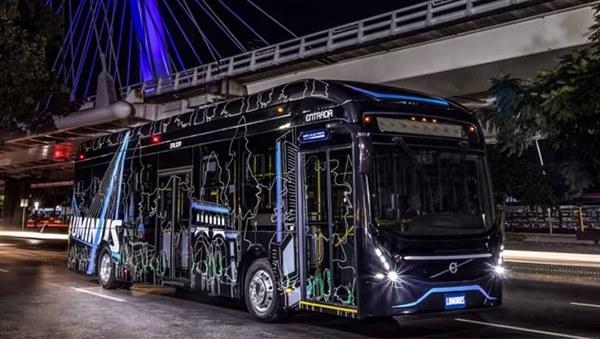 Guadalajara v Mexiku s 53 novými elektrickými autobusy Volvo
Guadalajara v Mexiku s 53 novými elektrickými autobusy Volvo
 IVECO BUS vyrobí pro Itálii 80 minibusů Daily CNG
IVECO BUS vyrobí pro Itálii 80 minibusů Daily CNG





